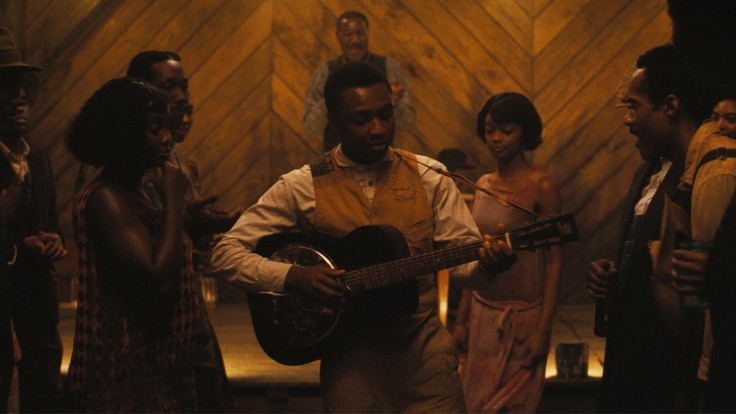
In Sinners, the supernatural horror film from director Ryan Coogler, music does not simply underscore emotion—it becomes the conduit through which history breathes, ghosts rise, and truth demands to be heard.
Released theatrically in April and now available for digital rental and purchase starting today June 3, with streaming to follow later this summer, Sinners has earned praise for its eerie atmosphere and devastating performances. But it's the music—composed by Oscar winner Ludwig Göransson and enhanced by field recordings, blues legends, and rising artists—that binds the film's emotional core to centuries of trauma, resistance, and cultural memory.
A Haunted Score Rooted in the Blues
Set in 1930s Mississippi during the height of Jim Crow, Sinners a story on film, another one on music. To tell this story sonically, Göransson went to great lengths to immerse himself in period-specific instruments and traditions. "I wrote much of the score on a 1932 Dobro Cyclops resonator guitar, because I wanted it to sound like the room, like the South breathing in pain," he said in a featurette released by Sony Music Masterworks.
The soundtrack, released April 18, is as much a character as any actor. It features raw, reverberating performances by Rhiannon Giddens, James Blake, Hailee Steinfeld, and blues legend Buddy Guy, whose track "Dirt on My Hands" conjures the agony of working-class life with the spiritual dread of the afterlife looming just beyond the next note.
Music as a Communal Weapon and Wound
At the heart of Sinners lies the role of music as communal ritual and collective catharsis—a survival tool used by oppressed communities to preserve culture, memory and fight erasure.
This isn't just a film about ghosts. It's about the haunting legacy of slavism, racism, and colonization. The film's score highlights how Black American music is not only a genre but a survival mechanism, passed down through spirituals, slave songs, delta blues, rock and roll, and rap. Each chord in Sinners feels inherited—an heirloom of grief and resilience.
Göransson's score weaves traditional African polyrhythms with distorted gospel vocals, deliberately unpolished. "We didn't want clean recordings," said music supervisor Tanika Johnson. "We wanted them to sound like they came from a dirt floor, a church with no pews, a scream in the woods."
The film's pivotal performance scene—set during a blackout as the juke joint erupts into a trance-like jam—is reminiscent of a voodoo ceremony. It is not accidental. Coogler, who co-wrote the story, said, "The juke joint becomes a spiritual battlefield. What the plantation couldn't kill, the music preserved."
Bridging Continents: Irish and African Diaspora Connections
What sets Sinners apart is its subtle but profound inclusion of Irish musical influence, which emerges in the final act when the mysterious White fiddler, played by Domhnall Gleeson, joins the soundtrack. His playing invokes sean-nós, a form of free-rhythm Irish singing known for its mournful tone and oral preservation.
This moment is not incidental. It ties into the film's undercurrent: the solidarity between colonized peoples. Irish folk traditions—born under British suppression, famine, and forced emigration—share emotional DNA with African-American music: an urgency to remember, to resist, to remain human.
The combination of African and Irish motifs in the same score is rare but powerful. One sequence layers a bowed Irish fiddle over a Yoruba call-and-response chant, creating a crescendo that feels like the past speaking in tongues. "It felt like the two griefs were dancing with each other," said Göransson. "Like they recognized the other's pain."
"Dangerous": A Love Song, a Curse, a Spell
Pop artist Hailee Steinfeld co-wrote and performs the original song "Dangerous," which plays during the film's climax and credits. Though contemporary in arrangement, the song borrows blues phrasing and features minimal production—just voice and resonator guitar.
"It's a woman's warning, a lament, and a prophecy," Steinfeld said in an interview with Variety. "It's about the price of silence in a violent world."
"Dangerous" is already seeing viral traction on TikTok, where creators have used it for everything from breakup montages to political protest clips. Like the film, the song's haunting refrain—"I sang and the devil stayed quiet"—feels both timeless and timely.ç
Streaming, Soundtrack, and Legacy
As of June 3, 2025, Sinners is available on Apple TV, Amazon Prime Video, and Google Play for digital purchase or rental. A physical 4K UHD and Blu-ray release is planned for July 8, and streaming availability on Max (formerly HBO Max) is expected in late July, though the exact date is still to be confirmed by Warner Bros. Discovery.
The soundtrack, released by Sony Masterworks, is now streaming on Spotify, Apple Music, and Tidal, and includes both the original score and featured songs.
In Sinners, the music is not a tool of exposition—it is the exorcism. By drawing from African and Irish musical lineages, Göransson and Coogler craft a soundscape that mourns, remembers, and defies. It's more than a soundtrack. It's a requiem for the forgotten—and a rallying cry for the living.
Originally published on classicalite.com
© 2025 Classicalite All rights reserved. Do not reproduce without permission.







